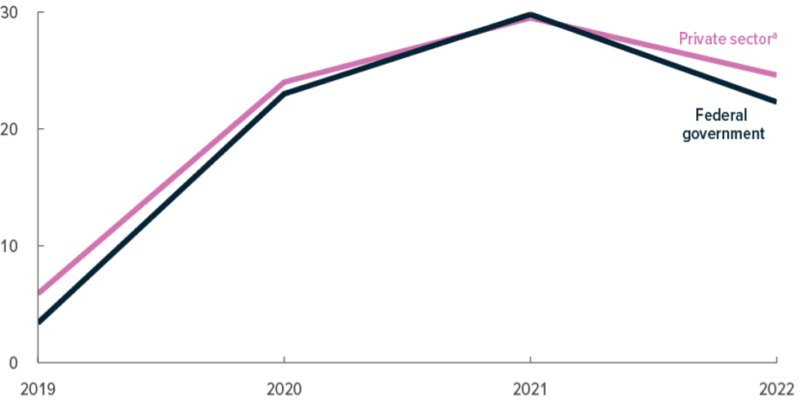 Limited evidence indicates that U.S. workers would be willing to give up about 8 percent of their salary, on average, to work from home about half the time. Image: Rawpixel.com/Shutterstock.com
By: FEDweek Staff
Limited evidence indicates that U.S. workers would be willing to give up about 8 percent of their salary, on average, to work from home about half the time. Image: Rawpixel.com/Shutterstock.com
By: FEDweek StaffFollowing is the section of a recent Congressional Budget Office report on comparisons of rates of telework by federal employees vs. private sector employees. While it was only a small part of an overall comparison of pay and other factors, the telework section has drawn attention, including in recent House hearings, for its findings that overall, federal employees have teleworked at lower rates—contrary to the assertions of many in Congress.
Most workers are willing to accept a job that pays less if it gives them the option to work from home. For that reason, providing more telework options might decrease the compensation that the federal government has to offer, relative to compensation in the private sector, to attract and retain highly qualified employees. (Providing fewer telework options would have the opposite effect.)
CBO used data from the American Community Survey (an annual survey conducted by the Census Bureau) to compare telework rates of federal employees and their private-sector counterparts. Whereas the CPS has little data on telework, the American Community Survey asks workers how they “usually” get to work and provides “works from home” as one of the options respondents can select. Thus, the telework rates CBO estimated probably represent the percentage of workers that work from home most of the time, including those who always work from home.
In both sectors, telework rates nationwide spiked during the coronavirus pandemic (in 2020 and 2021) and then partially receded (see Figure 4-1). In 2022, CBO estimates, 22 percent of federal employees usually teleworked, as did 25 percent of their private-sector counterparts. The telework rate for the private sector would have been lower had CBO not adjusted for differences in employees’ education, location, and occupation. Telework was more common among more educated workers in both sectors (except for workers with a professional degree or doctorate in the private sector, who teleworked less than private-sector workers whose education culminated in a bachelor’s or master’s degree). Furthermore, telework was more common in urban areas. In 2022, the rate of telework for employees in the Washington, D.C., metropolitan area, for instance, was 38 percent for federal employees and 40 percent for their private-sector counterparts, in CBO’s estimation.
Figure 4-1.
Percentage of Employees Who Typically Work From Home, by Sector
Federal employees and their private-sector counterparts telework at roughly similar rates. In both sectors, telework rates spiked during the coronavirus pandemic (in 2020 and 2021) and then partially receded.
Notes
Data sources: Congressional Budget Office; Census Bureau, the American Community Survey, from IPUMS-USA. See www.cbo.gov/publication/59970#data.
a. The telework rate for private-sector workers who resemble federal workers in occupation, years of work experience, and certain other observable characteristics that are likely to affect telework.
The ability to telework is highly dependent on occupation. In 2022, federal employees were more likely than workers in the private sector to serve in occupations in which telework was common. In the computer and mathematical occupations, which employed a larger portion of federal workers than private-sector workers in 2022, for example, teleworking was most common. The rates of telework for people in those occupations differed by sector, though—37 percent for federal workers, compared with 56 percent for their private-sector counterparts in 2022. One reason for the much higher telework rate for private-sector workers might be that federal workers are more likely to be required to go to the office to access sensitive data. Federal employees working as operations research analysts, for example (a common occupation in the Department of Defense that often requires a security clearance), are less likely to telework than their private-sector counterparts.
Federal employment was also common in some occupations in which telework was rare in 2022. Among federal workers in the areas of nursing, law enforcement, and transportation security screening, for example, the telework rate in 2022 was less than 10 percent—probably because those occupations require frequent in-person interactions. By contrast, other occupations in which telework is rare (such as construction, production, and transportation) employ few federal workers.
Less teleworking overall among federal workers than their private-sector counterparts might have slightly reduced the appeal of working for the federal government in 2022. Limited evidence indicates that U.S. workers would be willing to give up about 8 percent of their salary, on average, to work from home about half the time. Other research has found that the ability to telework increased employee retention at a large technology firm. The telework rate was only about 2 percentage points lower for federal employees than for their private-sector counterparts in 2022, though, CBO estimates. That finding suggests that because only a small portion of federal employees would be able to telework more if they instead worked in a similar occupation in the private sector, the average effect of less telework on the appeal of federal employment was small.
Deferred Resignation Periods about to End for Many; Overall 12% Drop
Retirement Surge Likely as Deferred Resignation Periods End
Senate Rejects Bills to Defer Shutdown; Familiar Process Lies Just Ahead
Senate Bill Would Override Trump Orders against Unions
Report Describes Impact of Shutdown on Employees, Agencies
TSP Adds Detail to Upcoming Roth Conversion Feature
See also,
Legal: How to Challenge a Federal Reduction in Force (RIF) in 2025
How to Handle Taxes Owed on TSP Roth Conversions? Use a Ladder
The Best Ages for Federal Employees to Retire
Best States to Retire for Federal Retirees: 2025
Retention Standing, ‘Bump and Retreat’ and More: Report Outlines RIF Process


